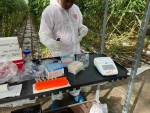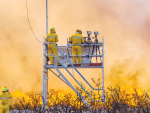A new research winery in the heart of New Zealand’s vine country will be a “drawcard” for international researchers, says MJ Loza.
Speaking at the opening of the Bragato Research Institute (BRI) facility - with its bespoke-tank technology and sustainable, future-proofed design - the BRI Chief Executive said it would enable valuable collaborations around the world, as well as throughout New Zealand.
“While based regionally in Marlborough we are here for New Zealand’s entire winegrowing industry, operating nationally, with global reach.”
The BRI and its research winery received start-up funding from the Ministry of Business, Innovation and Employment (MBIE) and Marlborough District Council, and are intended to add to the industry’s research capability, not duplicate it, he told the audience.
“We need to be expert in our chosen fields and partner with the very best in New Zealand and globally.”
That meant expanding on research to benefit New Zealand’s wine industry, while developing new research capability; promising science excellence, while “connected and collaborating with the world’s best”, MJ said.
The new winery would ensure research to a standard of excellence that the industry - and its wines - deserve, he added.
“We’ll conduct winemaking trials and we’ll take vineyard trials through to finished wines, under levels of experimental control not possible in New Zealand before.”
Aside from the winery, BRI has research priorities around sustainability, climate change, grapevine improvement, industry research data and technology transfer - “making sure the industry’s research is taken up and applied for real benefit”.
MJ said the winery’s location at the Marlborough Research Centre in Blenheim - alongside Plant & Food Research, the Nelson Marlborough Institute of Technology (NMIT), Wine Marlborough, and New Zealand Winegrowers - was strategic, enhancing the ability to “build connections between research, industry and education”.
Winery Establishment Manager Tracy Atkin acknowledged the commitment of the Marlborough-based project team that worked to design and refine the winery and its specialist trial tanks, which have inserts to enable four-in-one fermentation and automated functions for remote control.
She also applauded the efforts and initiative of the contractors behind it, who delivered the facility and its fittings in time for vintage 2020, just nine months after it received the go-ahead.
“Not only did we not need to go outside of the Marlborough/Tasman region for anything, I don’t believe we would have the result we have today if we were anywhere else,” she told guests at the opening.
“The team have worked as a community on this, continually coming up with new ideas and inspiration, working together for what you see today.”
Andy Frost was one of the industry representatives on the working group, and helped design the 200-litre tanks, then refine them after replicated trials were conducted in the first tranche in the 2019 vintage.
Seeing the completed winery, its floor lined with rows of world-first tanks, was “exciting” and a real step up for the wine industry, which increasingly recognised the value of research, Andy said. He was struck by the “tidiness” of the winery layout, with few fittings extruding from the pedestals, despite the winery having all its bells and whistles.
“The overall design is really exciting - it will be an absolute breeze to operate.” Andy, who was involved in a lot of research while at Pernod Ricard, said industry members were eager to help make the research winery the best it could be, reflecting the information sharing that is typical of the industry.
“There was no holding back because they knew it was for the good of all.”





